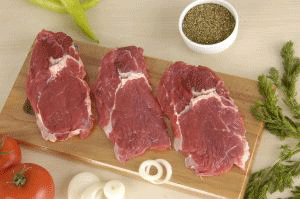 When you envision a grilled steak, you typically imagine a huge, marbled cut of meat full of saturated fat and cholesterol. With the summer grilling season in full swing, it’s important to be able to enjoy your favorite foods in moderation.
When you envision a grilled steak, you typically imagine a huge, marbled cut of meat full of saturated fat and cholesterol. With the summer grilling season in full swing, it’s important to be able to enjoy your favorite foods in moderation.
Kari Underly of Range Partners is a third generation meat cutter and offered us some of her top tips on choosing and preparing the proper cuts of steak for your summer cookouts.
“It’s so important for grocery stores and chefs to know how to sell various cuts of steak,” said Underly. “The proper portion of steak is 3-4 ounces and a lot of cuts have multiple portions in one steak. The average consumer has know way of knowing any better.”
High in zinc, iron and protein, a moderately sized steak is nutritionally dense and can be very good for you if you choose the right cut and cook it well.
Choose the Proper Cut
Heading to the meat counter to choose your cut of steak can be overwhelming. As a general rule, loins, ribeye and sirloins are more expensive, higher-quality cuts of meat. Anyone shopping on a budget should look for a flat iron, chuck eye, top sirloin or cap steak, which are all moderately priced.
Know the Grades
“A lot of grocery stores sell different grades of meat,” said Underly. “Sometimes, someone will see the word Choice or Select on a label and they don’t know what it means. Prime steaks typically have the highest fat content and Choice cuts will be more tender than the Select cuts, so think Prime then Choice then Select. The grocery store usually carries Choice and Select, and you’ll find Prime in a specialty store but it’s not a healthy cut.
According to Underly, a lot of novice grillers make a common mistake: they purchase a high-end cut of meat and they marinate it. “Not all steaks need to be marinated,” said Underly. “Plus, some store-bought marinades have heavier enzymes and can affect the texture of the meat.” If you have a ribeye or tenderloin, your meat probably doesn’t need a marinade. “Use acidic marinades for lesser cuts of meat,” said Underly.
When you do marinate steak, Underly suggests using a Ziploc bag to give you an even, consistent coating on the steak. “Put your meat in the bag and add just enough marinate to coat 1/4 inch of the steak,” said Underly. “Press the air out of the bag as you seal it and before you grill, pat the meat dry, gently.” Drying your meat might seem counter-intuitive but it will result in a juicier steak that doesn’t char on the outside.
High vs. Low Heat
“My advice for anyone behind the grill is to take your time and cook slowly,” said Underly. “When you cook on high temperatures you’re more likely to char the steak, and charring has been said to be carcinogenic.” Most steaks
cook relatively quickly, even over a moderate temperature.
Use a meat thermometer whenever possible to know when your steak is finished cooking. “Unlike poultry, which has to be cooked to 160 degrees F, or pork, which needs to reach 145 degrees F, you can pull a steak off the grill at about ten degrees below its desired doneness,” said Underly.
Gas vs. Charcoal
While a charcoal grill can impart delicious flavors into your steak, it can also be more challenging to new or first-time grillers. Whether you’re cooking with gas or with charcoal, cook over a medium heat for a nice, even sear.
Try These Easy and Delicious Steak Recipes:
Sirloin Steak with Spicy Herb Marinade

